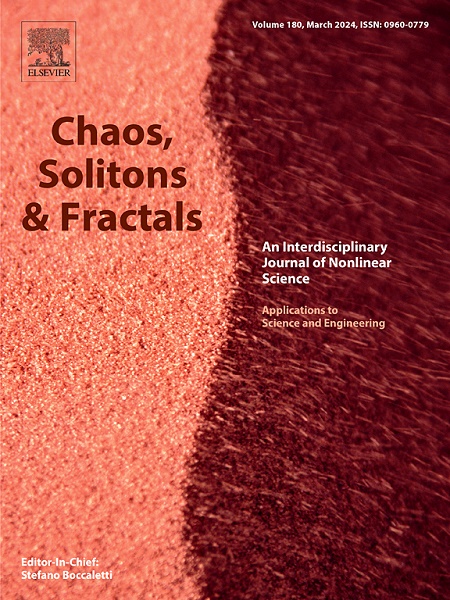次近邻相互作用对神经元微管内离散能量传递动力学的影响
IF 5.6
1区 数学
Q1 MATHEMATICS, INTERDISCIPLINARY APPLICATIONS
引用次数: 0
摘要
在这项研究中,我们使用解析和数值方法研究了次近邻相互作用或同型二聚体耦合对神经元微管(nmt)中量子呼吸体动力学的影响。从用哈密顿量描述微管动力学的经典模型出发,我们通过玻色算子推导出其量子等效。利用Ehrenfest定理和Glauber相干态方法,我们证明了nMT动力学可以用离散非线性Schrödinger方程(DNLSE)来描述。对调制不稳定性(MI)的分析使我们能够定义呼吸器的定位区域,揭示第二耦合项和井宽对系统行为的影响。我们进行了数值模拟,研究了三种基于同型二聚体和异源二聚体耦合值与呼吸传播有关的情况。我们发现,同型二聚体偶联增强了能量的时间分布,并将呼吸定位扩展到中心位置。此外,我们观察到nmt内的能量受同型二聚体耦合的影响,以线性轮廓量子化。两个呼吸体之间的相互作用表明,这种耦合也会影响能量交换,影响微管的集体动力学,并可能稳定或破坏结构,从而影响神经元的反应。这些发现加强了对神经系统等生物系统中能量传递的理解,神经系统负责协调身体内的行动和快速交流。这个系统,也被称为神经元系统,利用突触传递信号。在这个过程中,神经元释放化学神经递质,可以影响接收细胞的活动。本文章由计算机程序翻译,如有差异,请以英文原文为准。
Influence of next-nearest neighbor interactions on the dynamics of discrete energy transport within neuronal microtubules
In this study, we investigate the influence of next-nearest neighbor interactions or homodimer coupling on the dynamics of quantum breathers in neuronal microtubules (nMTs) using both analytical and numerical methods. From the classical model describing the dynamics of the microtubule using a Hamiltonian, we formulated its quantum equivalent through Bose operators. By employing Ehrenfest’s theorem and Glauber’s method of coherent states, we showed that nMT dynamics can be described by the discrete nonlinear Schrödinger equation (DNLSE). The analysis of modulational instability (MI) allowed us to define localization zones for breathers, revealing the impact of the second coupling term and well width on system’s behavior. We conducted numerical simulations to examine three scenarios based on homodimer and heterodimer coupling values in relation to breather propagation. We found that homodimer coupling enhances the temporal distribution of energy and extends breather localization towards the central site. Additionally, we observed that energy within nMTs is quantized with a linear profile, influenced by homodimer coupling. The interaction between two breathers indicated that this coupling also affects energy exchanges, impacting the collective dynamics of microtubules and potentially stabilizing or destabilizing configurations, thereby influencing neuronal responses. These findings enhance the understanding of energy transfer in biological systems such as the nervous system, which is responsible for coordinating actions and rapid communication within the body. This system, also known as the neuronal system, utilizes synapses to transmit signals. In this process, neurons release chemical neurotransmitters that can influence the activity of receiving cells.
求助全文
通过发布文献求助,成功后即可免费获取论文全文。
去求助
来源期刊

Chaos Solitons & Fractals
物理-数学跨学科应用
CiteScore
13.20
自引率
10.30%
发文量
1087
审稿时长
9 months
期刊介绍:
Chaos, Solitons & Fractals strives to establish itself as a premier journal in the interdisciplinary realm of Nonlinear Science, Non-equilibrium, and Complex Phenomena. It welcomes submissions covering a broad spectrum of topics within this field, including dynamics, non-equilibrium processes in physics, chemistry, and geophysics, complex matter and networks, mathematical models, computational biology, applications to quantum and mesoscopic phenomena, fluctuations and random processes, self-organization, and social phenomena.
 求助内容:
求助内容: 应助结果提醒方式:
应助结果提醒方式:


